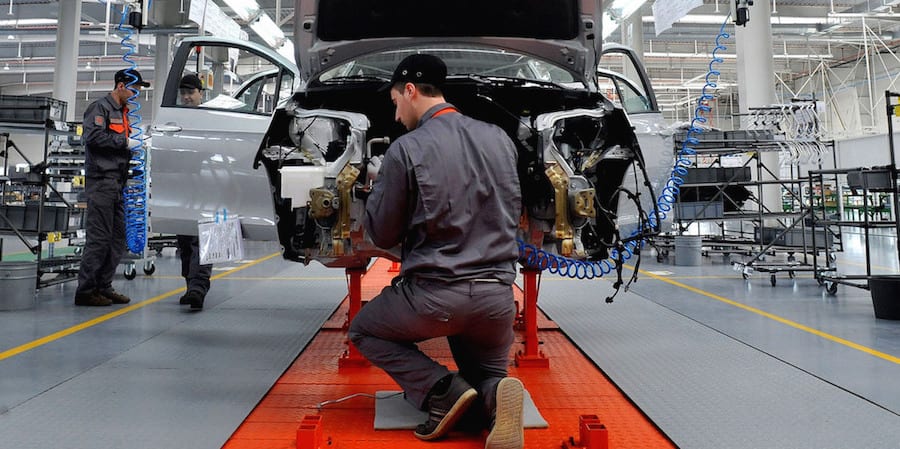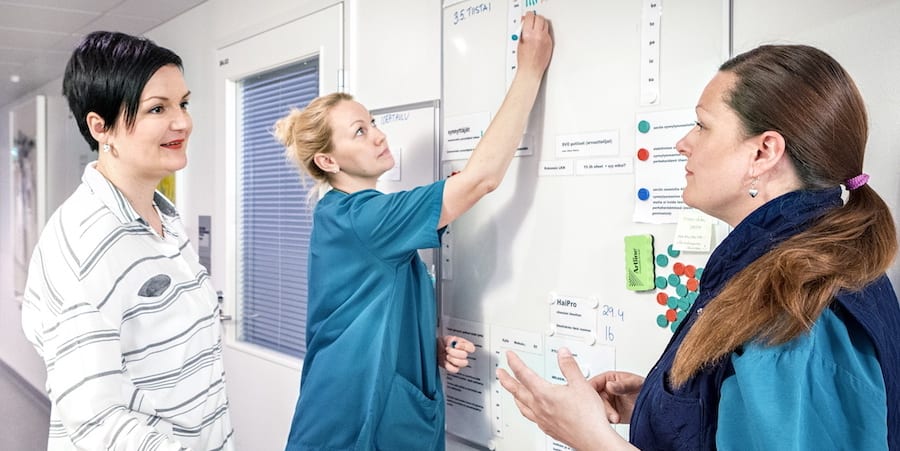
Lean management in a Brazilian insurance company
CASE STUDY – An insurance company in São Paulo is experiencing a complete turnaround driven by a very capable Lean Office that understands its role is to gradually make people autonomous.
Words: Luciana Gomes, Process Supervisor, SulAmérica – São Paulo, Brazil
Come see us at SulAmérica today and you’d find it hard to believe that up until 2014 we had no structured way of measuring performance, gather data, and set targets. Lean thinking has taken us by storm, and in just a few months it has completely transformed how we work.
Lean originally came to us as a recommendation by the consulting firm we had hired to draw a transformation plan for us. The aim of our lean journey was to centralize, reorganize and optimize the processes of the Operations and IT areas. However, it is clear it also offers us an opportunity to become more outward-looking and start focusing not only on operational excellence, but also on delighting our customers.
Even though the transformation so far has been driven by the Lean Office (a result of the fact that it began as a top-down initiative), we are already starting to see signs of departments and business areas becoming autonomous in using lean to improve. Based on the business challenges it identifies, management is asking us to reach out to certain areas of the company, but it is great to see people are starting to come to us spontaneously more and more. That’s the whole point!
The strategic issues we are helping tackle are all mapped on our Lean Wall, which is where we do our hoshin planning. This might refer only to the work of the Lean Office, but in reality, it ends up impacting several parts of SulAmérica. We have already started to support a number of business units (including Health & Dental, which represents a whopping 75% of our business), and that’s where we expect the biggest impact of the lean transformation to be felt.

In 2017, our main hoshin was to ensure the dissemination of lean across the organization. We want to give everyone in the business the opportunity to learn about lean thinking, and we have several ways in which we try to reach the whole of SulAmérica (training is offered to anyone interested in participating).
The first step in our capability development efforts is e-learning, which is followed by a practical application of lean principles: people are asked to pick a problem to solve (this is often suggested by leadership, and that’s why it’s been critical to have them involved). A3 Thinking training is offered every month in both São Paulo and Rio de Janeiro (our two main offices), and we travel fairly regularly to other branches around Brazil to make sure remoteness doesn’t become a hindrance to change. Of course, getting different professionals in the same room alone has a positive effect on the work of the branch. Another initiative is the collaboration with the Human Resources department to shape the thinking of those attending the company’s Leadership School using the Lean Transformation Framework as a reference model. During the classes, leaders go to the gemba and visit some of the areas with the most solid lean initiatives to see the LTF working in practice, to exchange experiences and to help translate useful lean tools into their reality.
One of our biggest efforts, however, is ensuring we are effective at communicating with employees. We have our own internal “bulleting” – we call it Lean News – which comes out twice a week. It’s a great way to show progress and help people see how widespread lean change is becoming within the business. We are happy to see articles are being read more than ever before (videos seem to be particularly popular, but that’s no surprise in the age of Youtube).
We also ran a Lean Day, in 2015, in order to start disseminating the lean culture across the whole company. It was the first opportunity to expose our people to lean transformations taking place elsewhere. At this first edition, we had Cesar Gon, CEO of IT company CI&T, and Dr Frederico Pinto, CEO of the Instituto de Oncologia do Vale. Both presentations made for incredible learning opportunities – what Dr Fred told us about lean as a management system was particularly helpful in getting our leadership team on board.
The Lean Day was so successful that we are scheduling another one for 2018. This year we will be running an A3 contest. (We already have more than 750 employees participating, with more than 200 A3s). Twenty winners will be selected, receive a trophy and present their A3s to all their colleagues. Out of those 20, two – selected by the management (including the President) – will win a trip to Disneyworld in Orlando (it was their idea to use this as an incentive to put the A3s in action). Under this new format, everyone will have a chance to talk to management, which will go a long way engaging people in the lean transformation. At the same time, taking top management to select the best A3s will help them see the impact lean is having on SulAmérica. A win-win!

STANDARDS AND COACHING
We have found that part of the success of a lean transformation rests with your ability to get the specifics right: this means that at SulAmérica we have been getting very granular when it comes to developing standards. It would seem we have one for everything, starting with the Lean News. Not only are we telling people what makes for a good “story” and what to avoid, but we are also giving them useful tips on how to take good pictures to go with the articles.

We have even developed standardized work on how to do a strategic A3, in two versions – one for the project manager, one for the facilitator from the Lean Office. Of course, these Job Instructions are not meant to replace us; they are just a preparatory step, something that people can turn to if they have any doubts. The main objective of standardized work is to help the project manager understand his role throughout the project, even before it starts. Nevertheless, we are present throughout the strategic A3 process.
We are very aware of our role as coaches, but at the same time we are trying to incorporate best practices in the work, so that people become less and less reliant on us. A big part of this is personal development (all of us have an A3 on it): we routinely ask people to observe coaching sessions as well as running them, and to take notes of what they see working or not working. This is critical in highlighting the behaviors that make for good coaching and consolidating them into some kind of a “method” that people can follow.
The groundwork we have laid down has been paying off. Not only have we had over 300 A3s opened and carried forward by our people, but we have also seen incredible results across the organization. A recent example? In the healthcare area, we have realized that ordering special materials (like prosthetics) ourselves rather than having the hospitals do it could save us a lot of money. We had to build the whole process – we call it Sourcing, because there was no standard for negotiating with hospitals and providers. Before lean, each employee was responsible for a number of hospitals and negotiated all cases from these hospitals end to end. All the negotiation was conducted using personal emails. We had no idea of the amount of stock we had.
By segmenting the work (initially in two phases, pre- and post-surgery, and now in eight phases: Capturing, Reconciliation, Negotiation, Provider support, Post billing, Pricing, Complex cases and Projects, each having a standardized work) and involving the hospitals in our lean efforts, we managed to turn things around. Today we can pay the providers in less than 15 days on average, whereas before lean the average was above 30 days! All stock is strictly controlled and managed.
Other results obtained through lean strategic projects include:
- In the Dental Insurance Regulation department, productivity increased from 5,760 processes per auditor per month to more than 14,500.
- The time it takes us to provide a reimbursement preview (the client who is to undergo a medical procedure and wants to know the total amount of the reimbursement) has dropped from 8 days to 1-2 days.
- Reimbursement devolution (when the client sends medical expenses receipts but we need to get further information or are unable to offer coverage), we get back to them in 2 to 5 days (previously it took us between 13 and 49!). We have also reduced devolutions from more than 9% a month to 4,7%.
Some areas within SulAmérica are starting to become more independent. While this is a good thing, at this time we still want to be able to observe them: we came up with a system to assess their efforts, gauge the level of maturity of the implementation, and identify successes and gaps.
We believe that observing others is a huge part of our lean transformation. This sort of “cross-fertilization” inspires people, provides them with new ideas and strengthens their conviction to keep going – but for that to happen we still need to point people in the right direction. We think this is going to be instrumental as we try to extend our reach to other corporate areas, like the Finance and the Legal departments.
We are thrilled that people are becoming autonomous in their problem-solving activities. This was our idea all along: we expose them to lean ideas and then leave it to them to figure out how to adapt them to their circumstances. It’s a sort of pull system for lean: SulAmérica employees are given access to the knowledge and can decide to pull it whenever they feel the need.
We have a long way to go before all of our 5,000 people are thinking lean, but we are very optimistic about the future.
THE AUTHOR

Read more


FEATURE - The original TPS "house" had levelled production at its foundation because Toyota understood that establishing and sustaining continuous improvement is impossible without creating stability in production first. What about your transformation?


FEATURE - Effectively dealing with a problem means learning to solve it in a variety of scenarios, not perfecting a point solution. For too long in lean we have only focused on gaining reusable knowledge... but what about reusable learning?


FEATURE – Embracing lean is like painting: tools are colors, respect for people is the brush, and true change blends both with intention.


CASE STUDY – The whole of Helsinki’s hospital district is leaning out, with incredible results. It isn’t every day that we come across – let alone have the opportunity to observe – a lean transformation in such a large healthcare organization.

